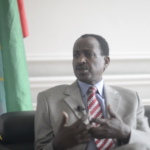- Stay Connected
Ethiopian Ambassador: ‘Anti-peace elements’ took advantage of Oromia, Amhara protests

Having been to Ethiopia, I can see a lot of the positives of what is going on in the country. But it seems that since last November, there’s been a large death toll of protesters that has started to worry people in the development community and in the EU itself, so I wanted to start by asking for the government figure of how many people have died in the past 12 months.
Firstly, thank you for coming, and secondly, thank you for your interest in Ethiopia. Regarding the question, AU (African Union), EU institutions, member states, are concerned on this question on Ethiopia – we are concerned.
Regarding the unrest in the last few years, we need to put it in some perspective. The first is that in the last 15 years, Ethiopia has made remarkable progress in the economy, infrastructure, social progress, that’s the bigger picture. That has benefited farmers, people in urban centres, the private sector. And these policies have delivered.
Those who benefited are now demanding more infrastructure, more energy. In the last 15 years, we have reduced poverty by 50% – meeting every one of our MDGs (Millennium Development Goals). When we started on these goals 15 years ago, the poverty level was 44%. Now it is 22%.
Even so, that still leaves us with around 22m people in poverty, and this is because of huge demographic [challenges] we have in the country. If you look at our achievement in education, we have also expanded access, facilities and infrastructure. We met our MDGs, and we tried to link education with industry and manufacturing, but today we have significant [numbers] of unemployed graduates, particularly because of the demography in the Oromia and Amhara regions. That is one perspective I want to put in the right setting.
Secondly, as the economy expanded, the question of economic governance becomes a huge issue. And we have a problem of course creating efficient and good governance. People are not satisfied with the level of delivery. As much as we have delivered, there are people have not benefited enough from our programme – the youths. So there have been grievances.
And the grievances from unemployment, and more demands from the public – that, and other issues, led to the problems we had last November.
Of course, you remember the Addis Ababa masterplan issue – which was one of the triggering factors for the demonstrations that took place in the Oromia area. What happened after that was we tried to engage the public in the two regions. The issue of identity has been responded to by the pertinent regional authority, and the issue of the masterplan – after seeing the discontent of the Oromia people, we did put off.
Related to this was the issue of land. Land has been taken from the private sector – always with compensation, of course – for areas for investment, in the regions of Oromia and Amhara. Farmers have been complaining they have not been paid sufficient compensation. Or after getting compensation, they were not getting support to make their next move or next opportunity.
So we have seen gaps there. All this led to the unrest we have seen in both regions. Youth unemployment and good governance – but those are an issue everywhere, not just those two states.
But later on, a Human Rights Commission investigated, and it came up with a finding, that was public and presented to the house of representatives in the federal parliament, in the first report, that found yes, there was loss of life, destruction of property and also loss of life of law enforcement agents.
Coming back to the recent unrest in the two regions, this time in Amhara, it was not identity or employment, there was a question of particular development in Gondar, so we witnessed unrest in that part. But later, as other cities joined in the demonstration, most of it, frankly, (was) illegal, because nobody took responsibility for who organised it. It was organised on Facebook, most of it was violent, and that’s totally illegal in the context of Ethiopian law. Because demonstrations need permission, a time, and a place – and this was not the case.
Secondly, there were anti-peace elements who took advantage of the demonstrations, and it was not peaceful anymore. That can clearly be seen.
